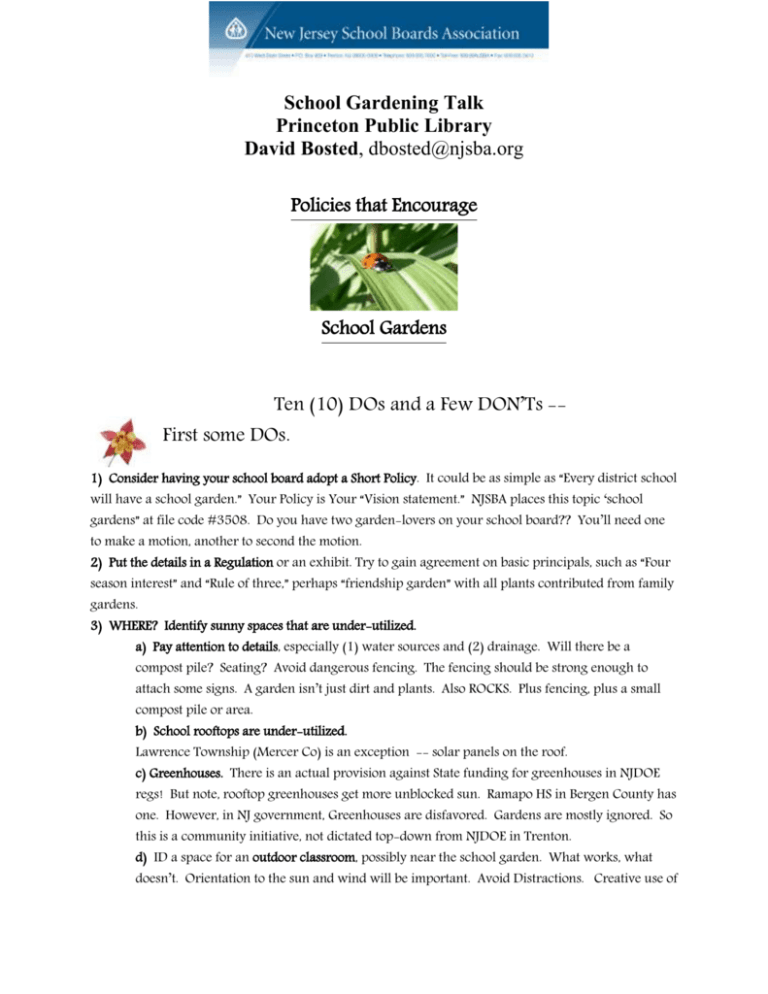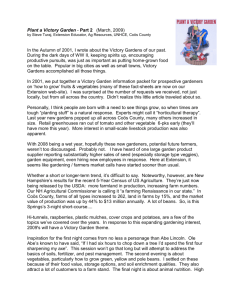
School Gardening Talk
Princeton Public Library
David Bosted, dbosted@njsba.org
Policies that Encourage
School Gardens
Ten (10) DOs and a Few DON’Ts -First some DOs.
1) Consider having your school board adopt a Short Policy. It could be as simple as “Every district school
will have a school garden.” Your Policy is Your “Vision statement.” NJSBA places this topic ‘school
gardens” at file code #3508. Do you have two garden-lovers on your school board?? You’ll need one
to make a motion, another to second the motion.
2) Put the details in a Regulation or an exhibit. Try to gain agreement on basic principals, such as “Four
season interest” and “Rule of three,” perhaps “friendship garden” with all plants contributed from family
gardens.
3) WHERE? Identify sunny spaces that are under-utilized.
a) Pay attention to details, especially (1) water sources and (2) drainage. Will there be a
compost pile? Seating? Avoid dangerous fencing. The fencing should be strong enough to
attach some signs. A garden isn’t just dirt and plants. Also ROCKS. Plus fencing, plus a small
compost pile or area.
b) School rooftops are under-utilized.
Lawrence Township (Mercer Co) is an exception -- solar panels on the roof.
c) Greenhouses. There is an actual provision against State funding for greenhouses in NJDOE
regs! But note, rooftop greenhouses get more unblocked sun. Ramapo HS in Bergen County has
one. However, in NJ government, Greenhouses are disfavored. Gardens are mostly ignored. So
this is a community initiative, not dictated top-down from NJDOE in Trenton.
d) ID a space for an outdoor classroom, possibly near the school garden. What works, what
doesn’t. Orientation to the sun and wind will be important. Avoid Distractions. Creative use of
paving. It can all be donated, as in the fabulous paving garden at the Brooklyn Museum, next to
the Brooklyn Botanical Garden. PA blue stone. Old bricks -- Lawrence Nature Center – built of
bricks recycled from Trenton’s kilns. [There were 270, now only 1].
4) Link your garden to the curriculum.
5) WHO is assigned to the task of making the garden happen?
Is it in anyone’s JOB DESCRIPTION?
Is it one of the SUPERINTENDENT’S (or school principal’s) ANNUAL GOALS?
Usually there are a handful of goals selected for each year.
6) Incorporate a History Lesson, such as gardening on the homefront: Women’s Land Army of America
and the United States School Garden Army.
7) Use labels. What is it? You may know, but most visitors won’t.
8) Display in hallways -- diagrams, labeled tools. Display flowers at the reception desk. Publicity on
the website. Probably could use a publicity chair.
9) Applied technology is “In.” [“Shop” alas is disfavored]. Nutrition, wellness are also “in”
10) Add it to your policy -- an Annual award for graduating seniors. Top gardener or Green thumb
award.
DON’TS
1) Don’t get embroiled unnecessarily in obscure gardener disputes like -
Butterfly garden that can’t have butterfly bush (because it is non-native).
Perrenials only vs annuals only. Flowers only vs edible plants only.
Bamboo-lovers vs bamboo haters.
Policy can help by giving a focus or direction, and by balancing interests.
2) Don’t forget to have events, talks, presentations, announcements (the hemerocalis is blooming!).
Lawrence Nature Center – Tuesday Nite is Family Nite all Summer! Give examples of possible talks.
Talk about other gardens such as Longwood, other parks, arboretums.
FILE CODE: 3508
_ Monitored
__ Mandated
__ Other Reasons
NJSBA Sample Policy
SCHOOL GARDENS
The School Board encourages and supports the development of school gardens. New Jersey is called
“The Garden State.” School gardens can help students learn about nutrition and healthy eating.
Therefore, school buildings and grounds shall include provision for school gardens.
The chief school administrator may develop detailed plans and regulations for the safe and efficient
operation and maintenance of gardens on school grounds. Each school garden shall be under the
direction of one or more individuals from school staff or the community, designated by the superintendent.
Benefits of school gardens
Our local school garden is part of a nationwide rediscovery of gardening as a tool for hands-on, studentcentered learning. School gardens benefit classrooms and students by:
A. Addressing multiple learning styles/opportunities concerning:
1.
2.
3.
4.
5.
Plant growth and other natural processes;
Tools and their proper use;
Where food comes from;
Teaching patience and responsibility;
Teaching students to work cooperatively;
B. Focus on educational topics:
1.
2.
3.
4.
5.
6.
Promoting garden foods and good nutrition;
Improving environmental awareness;
Demonstrate best practice sustainable design;
The value of compost as a soil supplement, plus reducing landfill disposal of waste;
Link farm to school, in the Garden State;
Saving money while improving nutrition;
C. The role of phytochemicals and beneficial effects:
1.
2.
3.
4.
Against inflammation;
Oxidative stress;
Cancer; and
Cardiovascular disease.
D. Increasing physical activity;
E. Building classroom relationships and school spirit;
1. Improving social skills, socializing;
2. Creating an appreciation for team work;
3. Increasing self-esteem and self-worth.
F. Supporting interdisciplinary education;
G. Serving as an outdoor science lab to teach about:
Page 1 of 2
3/11
NJSBA LEGAL AND POLICY SERVICES
New Jersey School Boards Association, P.O. Box 909, Trenton, NJ 08605-0909
Copyright 2010 by NJSBA. All rights reserved.
1.
2.
3.
4.
Seed germination;
Composting;
The life cycle of plants;
Pollination and the parts of a flower.
H. Beautifying the school environment.
Integration of the School Gardens into the Curriculum
A. Integrate eating experiences, gardens, and nutrition education into the curriculum for math, science,
social studies and language arts at all grade level;
B. Establish a school garden in every school. Give students the opportunity to plant, harvest, prepare,
cook and eat food they have grown;
C. Establish relationships with local farms. Encourage farmers and farm workers to come to the school
for classroom talks and arrange for students to visit farms.
Community Support and Participation
The board encourages community participation in creating and maintaining the school gardens.
Community participation will be consistent with policies #1230, “School connected organizations” and
#1200 “Volunteers.”
Location and Design
The location and design of each school garden will be approved by the Superintendent, the school
principal and the director of buildings and grounds. Special consideration will be given to access to clean
water (or stored rainwater), good drainage, storage of tools, sunny orientation, blockage of harsh winds
from the north and northwest, beautification of school grounds, access by students, and student safety.
The garden design will promote accessibility and will include some seating.
Consideration will be given to creating raised bed gardens that include sections for herbs, garden
vegetables, flowering garden plants that bloom while school is in session, a small composting area, and a
small cold-frame to extend the growing season of the garden.
Poster contest
The district will sponsor a student poster contest, annually or as circumstances permit, to illustrate the
beneficial aspects of the school gardens, with awards. The posters will be displayed in appropriate
locations, in recognition of the artistic efforts of the students who create the posters.
Date:
Key Words
Operation and Maintenance of Plant, Buildings and Grounds, Maintenance, School-connected
organizations, Ad Hoc committees, Volunteers/participation of the public.
Page 2 of 2










